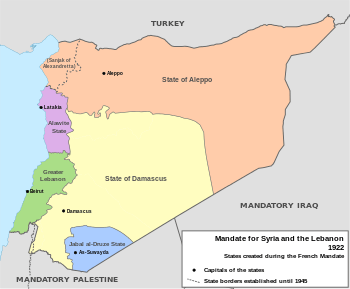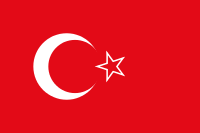Hatay State
| Hatay State | ||||||||||
| Hatay Devleti État du Hatay دولة خطاي | ||||||||||
| ||||||||||
|
| ||||||||||
| Anthem İstiklâl Marşı | ||||||||||
 | ||||||||||
| Capital | Antakya | |||||||||
| Languages | Turkish (official) French (second) Levantine Arabic | |||||||||
| Government | Republic | |||||||||
| Head of State | Tayfur Sökmen | |||||||||
| Prime Minister | Abdurrahman Melek | |||||||||
| Historical era | Interwar period | |||||||||
| • | Independence | September 7, 1938 | ||||||||
| • | Union with Turkey | June 29, 1939 | ||||||||
| Area | ||||||||||
| • | 1938 | 4,700 km² (1,815 sq mi) | ||||||||
| Population | ||||||||||
| • | 1938 est. | 234,379 | ||||||||
| Density | 49.9 /km² (129.2 /sq mi) | |||||||||
| Currency | Turkish liraa | |||||||||
| ||||||||||
| a. | Preceded by the Syrian pound. | |||||||||
Hatay State (Turkish: Hatay Devleti, French: État du Hatay, Arabic: دولة خطاي Dawlat Khaṭāy), also known informally as the Republic of Hatay, was a transitional political entity that existed from September 7, 1938, to June 29, 1939, in the territory of the Sanjak of Alexandretta of the French Mandate of Syria. The state was transformed de jure into the Hatay Province of Turkey on July 7, 1939, de facto joining the country on July 23, 1939. Hatay Province includes districts of Erzin, Dörtyol and Hassa in addition to former Hatay State territories.
History
Background
Formerly part of the Aleppo Vilayet of the Ottoman Empire, the Sanjak of Alexandretta was occupied by France at the end of World War I and constituted part of the French Mandate of Syria.
The Sanjak of Alexandretta was an autonomous sanjak from 1921 to 1923, as a result of the French-Turkish treaty of October 20, 1921, considering the presence of an important Turkish community along with Arab and Armenian ones. Then it was attached to the State of Aleppo, then in 1925 it was directly attached to the State of Syria, still with a special administrative status.[1]
Turkey under Mustafa Kemal Atatürk refused to accept the Sanjak of Alexandretta to be part of the Mandate and, in a speech on March 15, 1923 in Adana, claimed, that it was "a Turkish homeland for 40 centuries" and that "can't be a captive at the hands of enemy".[2] Turkish politics aimed at incorporating the Sanjak of Alexandretta when the French mandate of Syria would expire in 1935. Local Turks initiated reforms in the style of Atatürk's, formed various organisations and institutions in order to promote the idea of union with Turkey.

In 1936, the elections returned two Syrian independentist MPs (favoring the independence of Syria from France) in the sanjak, and this prompted communal riots and passionate articles in the Turkish and Syrian press. In particular, Arab nationalist Zaki al-Arsuzi was influential in anti-irredentist agitation.
In response, Atatürk government coined the name Hatay for the Sanjak of Alexandretta, as a reference to Hittites (Syro-Hittite states), and raised the "Issue of Hatay" (Turkish: Hatay Meselesi) at the League of Nations. On behalf of the League of Nations, representatives of France, the United Kingdom, the Netherlands, Belgium and Turkey prepared a constitution for the sanjak. The new statute came into power in November 1937, the Sanjak becoming 'distinct but not separated' from Syria on the diplomatic level, linked to both France and Turkey for defense matters.[1]

In 29 June 1939, following a popular referendum, Hatay became a Turkish province. This referendum has been labelled both "phoney" and "rigged", and a way for the French to let Turks take over the area, hoping that they would turn on Hitler.[3][4] For the referendum, Turkey crossed tens of thousands of Turks into Alexandretta to register as citizens and vote.[5]
Syrian President Hashim al-Atassi resigned in protest at continued French intervention in Syrian affairs, maintaining that the French were obliged to refuse the annexation under the Franco-Syrian Treaty of Independence of 1936.
Annexation
On June 29, 1939, the Hatay legislature voted on disestablishing the Hatay State and joining Turkey in order to increase the Turkish proportion of the population.. On July 7, 1939, the Grand National Assembly of Turkey approved the law establishing the Hatay Province and incorporating districts from Adana Province (then Seyhan Province) and Gaziantep Province. By July 23, 1939, the last vestiges of the French Mandate authorities had left Antakya, and the territory was fully annexed to Turkey. The result was a flight of many Arabs and Armenians to Syria.
Population and demographics
According to the estimates of the French high commission in 1936, out of a population of 220,000 39% were Turks, 28% Arabic-speaking Alawites, 11% Armenians, 10% Sunni Arabs, 8% other Christians and 4% were Circassians, Kurds and Jews. Although Turks formed the largest single ethno-religious minority, Arabic speakers including Sunnis, Alawites and Christians were more numerous.[6]
.jpg)
| Population of Hatay State in 1936 according to the French census[6] | ||||||
| Ethnic group | Inhabitants | % | ||||
|---|---|---|---|---|---|---|
| Alawis | 61,600 | 28% | ||||
| Sunni Arabs | 22,000 | 10% | ||||
| Melkites and other Christians | 17,600 | 8% | ||||
| Turks | 85,800 | 39% | ||||
| Armenians | 24,200 | 11% | ||||
| Circassians, Jews, Kurds | 8,800 | 4% | ||||
| Total | 220,000 | 100% | ||||
In popular culture

The State of Hatay was featured as one of the main locations in the 1989 film Indiana Jones and the Last Crusade. In the film, the Holy Grail is discovered in an ancient temple within Hatay, although the location used for the external shots of the temple is the Treasury of the ancient city of Petra, actually located in Jordan.
Aside from the name and location, most of the detail of Hatay within the movie is fictionalised - the flag is incorrect, and the state is shown as a monarchy with a sultan.[7]
See also
References
| Wikimedia Commons has media related to Hatay State. |
- 1 2 Picard, Elizabeth (January–February-March 1982). "Retour au Sandjak". Maghreb-Machrek (in French). Paris: Documentation française (99). Check date values in:
|date=(help) - ↑ "History of Hatay (In Turkish)". Antakyarehberi.com. Retrieved 2012-06-19.
- ↑ Jack Kalpakian (2004). Identity, Conflict and Cooperation in International River Systems (Hardcover ed.). Ashgate Publishing. p. 130. ISBN 0-7546-3338-1.
- ↑ Robert Fisk (19 March 2007). "Robert Fisk: US power games in the Middle East". The Independent. Retrieved 15 December 2010.
- ↑ Robert Fisk (2007). The Great War for Civilisation: The Conquest of the Middle East (Paperback ed.). Vintage. p. 335. ISBN 1-4000-7517-3.
- 1 2 Brandell, Inga (2006). State Frontiers: Borders and Boundaries in the Middle East. I.B.Tauris. p. 144. ISBN 978-1-84511-076-5. Retrieved 30 July 2013.
- ↑ Boam, Jeffery. "Indiana Jones and the Last Crusade - screenplay". Retrieved 27 October 2012.
Sources
- Sökmen, Tayfur: Hatay'ın Kurtuluşu İçin Harcanan Çabalar, Ankara 1992, ISBN 975-16-0499-0.
- Dr. Abdurrahman Melek, Hatay Nasıl Kurtuldu, Türk Tarih Kurumu, 1966
Coordinates: 36°25′49″N 36°10′27″E / 36.43028°N 36.17417°E
